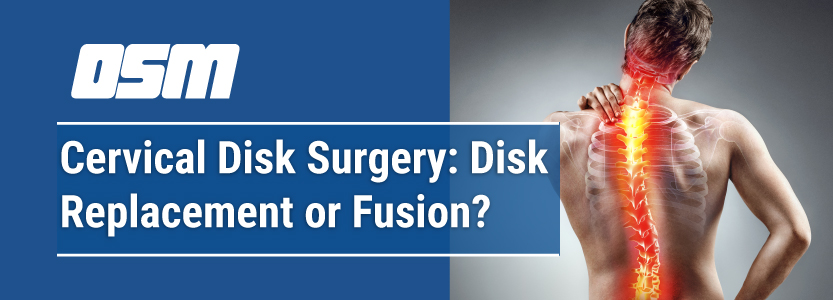Cervical Disc Surgery: Disc Replacement or Fusion?
Article featured on WebMD, medically reviewed by Sabrina Felson, MD
The vast majority of people — more than 90% — with pain from cervical disc disease will get better on their own over time with simple, conservative treatments. Surgery, however, may help if other treatments fail or if symptoms worsen to the point that weakness in your arms and or legs develop. This is called a cervical myelopathy and surgery is recommended.
Cervical disc disease is caused by an abnormality in one or more discs — the cushions — that lie between the neck bones (vertebrae). When a disc is damaged — due to degenerative disc disease (or DDD) or an unknown cause — it can lead to neck pain from inflammation or muscle spasm. In severe cases, pain and numbness can occur in the arms from pressure on the cervical nerve roots or spinal cord.
Surgery for cervical disc disease typically involves removing the disc that is pinching the nerve or pressing on the spinal cord. This surgery is called a discectomy. Depending on where the disc is located, the surgeon can remove it through a small incision either in the front (anterior discectomy) or back (posterior discectomy) of the neck while you are under anesthesia. A similar technique, microdiscectomy, removes the disc through a smaller incision using a microscope or other magnifying device.
Often, a procedure is performed to close the space that’s left when the disc is removed and restore the spine to its original length. Patients have two options:
- Artificial cervical disc replacement
- Cervical fusion
In 2007, the FDA approved the first artificial disc, the Prestige Cervical disc, which looks and moves much like the real thing but is made of metal. Since then, several artificial cervical discs have been developed and approved. Ongoing research has shown that the artificial disc can improve neck and arm pain as safely and effectively as cervical fusion while allowing for range of motion that is as good or better than with cervical fusion. People who get the artificial disc are often able to return to work more quickly as well. The surgery to replace the disc, however, does take longer and can lead to more blood loss than with cervical fusion. It’s also not known how the artificial discs will last over time. People who get an artificial disc can always opt for cervical fusion later. But if a patient has cervical fusion first, it’s not possible to later put an artificial disc in the same spot.
The Orthopedic & Sports Medicine Center of Oregon is an award-winning, board-certified orthopedic group located in downtown Portland Oregon. We utilize both surgical and nonsurgical means to treat musculoskeletal trauma, spine diseases, sports injuries, degenerative diseases, infections, tumors and congenital disorders.
Our mission is to return our patients back to pain-free mobility and full strength as quickly and painlessly as possible using both surgical and non-surgical orthopedic procedures.
Our expert physicians provide leading-edge, comprehensive care in the diagnosis and treatment of orthopedic conditions, including total joint replacement and sports medicine. We apply the latest state-of-the-art techniques in order to return our patients to their active lifestyle.
If you’re looking for compassionate, expert orthopedic surgeons in Portland Oregon, contact OSM today.
Phone:
503-224-8399
Address
17355 Lower Boones Ferry Rd Suite 100A
Lake Oswego, OR 97035
Hours
Monday–Friday
8:00am – 4:30pm



